Mount Everest Expedition
Mount Everest is the highest mountain in the world. This giant sits on the crest of the Himalayan Range between Tibet and Nepal.
This mount Everest expedition offers you a chance to see the great Mt.Everest. The best time to viewMt. Everest is early May and October. Due to the clear weather here, you will have a great chance to see the true face of Mt.Everest from head-to-toe. To view the sunrise and sunset here, you can do nothing but feel marvel for the nature’s masterpiece.
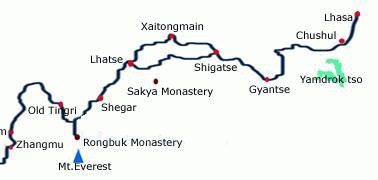
Interested in the Mount Everest Expedition Tour ?
Contact us for a quotation.
Itinerary day by day:
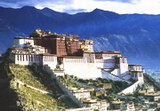 Potala Palace 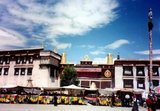 Jokhang Temple 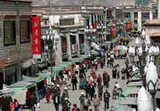 Barkhor Street 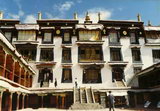 Drepung Monastery 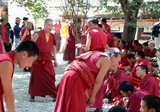 Sera Monastery 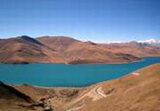 Yamdrok Lake 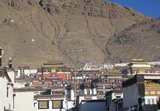 Tashilumpo monastery 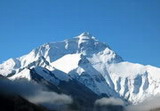 Mountain Everest |
Day1 Fly to Lhasa from Chengdu
Taking the flight into Tibet upon your arrival. Local guide will meet you and transfer you to Lhasa. On the way, you can enjoy the heart-beating highland view along the Yarlong Tsangpo river (the longest river in Tibet). The rest time is free for relax and more oxygen.
Day2 Potala Palace, Jokhang Temple, Barkhor street
The first day of sightseeing starts from Lhasa's cardinal landmark- Potala Palace, a structure of massive portions. Its towering image already appearing on various occasions, but your first sight of the Potala will still be an awe-inspiring moment. It takes at least a good 2-hour to visit those rooms, halls and chapels.
In the afternoon, we will drop a visit of the Jokhang Temple, the spiritual center of Tibet. Everyday, pilgrims from every corner of Tibet trek a long distance to the temple. The temple is the product of Han, Tibetan and Nepalese architectural techniques. Then we will visit Barkhor, the oldest street in a very traditional city in Tibet
Day3 Drepung Monastery, Sera Monastey
About 8km west of central Lhasa is the Drepung, once world's largest monastery with about 10,000 monks. This day's sightseeing begins with these white monastic buildings piled up on the hillside. Walking up to the hill is a pleasant thing, an easy break from the solemn ambience inside the halls and chapels. At the plat roof of hillside, you can have very good views of the whole Lhasa city and the distant mountains.
Drepung is one of Lhasa's two great Gelugpa monasteries, the other is Sera. Around 5km north of central Lhasa, Sera may not be as grandiose as Drepung, but is more serene surrounded by many small temples. The 'Buddhism Scriptures Debating' in Sera is very famous.
Day4 Lhasa-Gyantse
Today you will drive about 300KM to Gyangtse. Take a look at YamzhogYumco Lake on the way and overlook Kalais Kora Glacier. Yamdrok Lake is a coiling, many-armed body of water shaped like a scorpion. It doubles back on itself on the western side, effectively creating a large island within its reaches. For Tibetans, it is one of the four holy lakes of Tibet. And the home of wrathful deities. The lake lies several hundred metres below the road, and in clear weather is a fabulous shade of deep turquoise. Far in the distance is the huge massif of Mt. Nojin Kangtsang (7191m).
In the afternoon, you will arrive in Gyangtse and go for the tour of Palkhor Temple, built in the 15th century, is situated in the west of Gyantse Town with mountains enclosing form three sides of the east, west and north. Its uniqueness is that its three sects of Buddism-Shaja, Ningma and Guolu stayed harmoniously under one roof.
Day5 Gyantse-Shigatse
Drive
about 90KM to Shigatse which is the second largest city in Tibet. It’s
also the home town of Banchen Lama. In the afternoon, you will drop a
visit of Tashilumpo monastery. Tashilumpo, sprawls on
the slops of Mt. Niser, southwest of Shigatse. It covers an area of
about 300,000 square meters. There are many valuable and rare historical
articles in the monastery
En route, visit Shalu monastery, which the construction was started in 1027. Its architecture is of typical combination of the Tibetan and Chinese styles with archways, carved pillars, tilled roofs and the Song and Yuan style murals.
Day 06 Shigatse-Shegar
Today we drive to Shegar and overnight here. En route visit Sakya monastery,
which is divided into the south and north two parts. It is of typical
Yuan Dynasty style of resembling castles. There are a lot of historical
articles in the monastery, among them are found a lot of the imperial
certificates, gold signets, crowns, costumes bestowed by the Yuan
Dynasty emperors. It has over 10,000 volumes of Tibetan books on
astronomy, medicine, calligraphy, and history. So the Sakya monastery
enjoys the title ‘the second Dun Huang Cave.’
Day 07 Shegar-Rongbuk Monastery-Mt. Everest
Although it's just 100km from Shegar to Everest Base Camp
(5200m), it takes about 4 hours since the cracked winding roads demand
much caution. But the views are stupendous on a clear day, and feature a
huge sweep of the Himalaya range including peaks over 8000, Makalu,
Lhotse, Everest, Gyachung and Cho Oyu. When you finally get to Base
Camp, the first sight of the mighty Everest simply leaves you
speechless. All the hardship you bear along the way makes sense at this
while. The best moments to watch Mt. Everest's are early
morning and late evening when Everest is shining like a goddess in the
sunglow.
Day 08 Mt. Everest-Shegar-Lhaste
After view the sunrise of the Mt. Everest,
drive about 4 hours to back Shegar. Have a luch here, then drive back
to Lhaste. Tonight we will have our accommodation here. In Lhaste, there
is a quite characterized Farmer’s hotel, where they can offer Tibetan
dancing and singing show for free. You can have a funny night here after
visiting the stunning beautiful Mt. Everest.
Day 09 Lhasate-Lhasa
Today drive back to Lhasa.
Day 10 Lhasa-Chengdu
Take flight to Chengdu, tour ends.
Interested in the Mount Everest Expedition Tour ?
Contact us for a quotation.
Extension optional tours
A. one more day to Namsto Lake
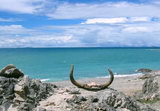 Namtso Lake |
Namsto Lake: Namsto, approximately 190km north-west of Lhasa, is the second-largest saltwater lake in China. It is over 70km long and reaches a width of 30km. They Nyenchen Tangula range, with peaks of more than 7000m, towers over the lake to the south. Namtso is a tidal lake and the ring marks of earlier lake levels are clearly visible by the shoreline. In clear weather the water is a miraculous shade of turquoise and there are magnificent views of the nearby mountains. The wide open spaces, dotted with tents of local nomads, are intoxicating.
B. one more day to Gandan Monastery or Tsurphu Monastery
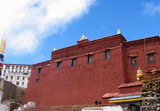 Gandan Monastery |
Gandan Monastery: Gandan, just 40km north-east of Lhasa, was the first Gelugpa monastery. If you only have time for one monastery excursion outside Lhasa, Ganden would probably be the best choice. With its stupendous views of the surrounding Kyi-chu Valley and fascinating kora, Ganden is an experience unlike the other major Gelugpa monasteries in the Lhasa area.
Tsurphu Monastery: Tsurphu Monastery around 70km west of Lhasa, is the seat of the Karmapa branch of the Kagyupa order of Tibetan Buddhism. The Karmapa are also known as the Black Hats, a title that dates back to 1256.
Interested in the Mount Everest Expedition Tour ?
Contact us for a quotation.
Destination Guide
Lhasa
Lhasa, capital of the Tibet Autonomous Region, covers an area of 544 square kilometers and is "The Land of Gods" in Tibetan, sits on the north bank of River Lhasa, a tributary of the Yarlung Tsangbo River, at an altitude of 3,700 meters. It has a history of over 13 centuries. With more than 3,000 hours of sunshine annually, Lhasa is famed as " the City of Sunshine". It is the capital of Tibet Autonomous Region and the center of Tibet's political, economic, cultural and religious activities. There are many historic sites and famous relics in the city proper and its suburbs, among which the Potala Palace, Jokhang Temple, Drepung Monastery, Sera Monastery and Ganden Monastery are world famous.
Gyantse
Gyantse was once considered to be Tibet’s third largest town-after Lhasa and Shigatse, but nowadays its status has undoubtedly diminished. Nonetheless Gyantse has preserved much of its old-world atmosphere, and Tibetan rural life continues here, virtually unchanged, against a backdrop of magnificent 14th-15th century fortresses and temples.
Shigatse
Shigatse, commanding the confluence of the Nyang-chu and Brahmaputra rivers, is still Tibet’s second largest city, but it may not remain so for long in view of the recent rapid development of other cities in East Tibet. The city is slightly higher than Lhasa, at 3,900 metres; with an oxygen content of 67 percent and average annual temperatures are 16℃ in mid-summer and -5℃ in mid-winter.
Mt. Everest
Mount Everest has many names. In Tibetan the name ‘Chomolongma’ means ‘Mother Goddess of the World’ in Nepalese the name ‘Sagarmatha’ means ‘The Forehead of the Sky’ Its English name, though not nearly as descriptive, connotes similar feelings of awe. At 8850m/29,035ft Mount Everest sits literally at the top of the world, nestled in the HimalayanMountains of Nepal.
Interested in the Mount Everest Expedition Tour ?
Contact us for a quotation.